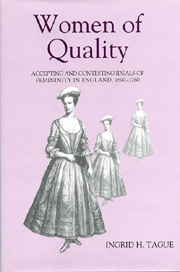Book contents
1 - Ideals of Femininity
Published online by Cambridge University Press: 12 September 2012
Summary
How did early eighteenth-century women know how to behave? What were the standards against which their actions were measured? As they always had, they learned from their parents, and from observing others at home, on visits, and in public. They listened, as they had for centuries, to sermons providing information both general and specific about virtuous life. And, more and more, they were exposed to feminine norms through print. The late seventeenth and early eighteenth centuries saw a tremendous boom in the publication and sales of all forms of printed material, of which women were important consumers. This trend in turn helped to create and feed a demand for literature aimed specifically at women, which both responded to changing perceptions of women's roles in society and shaped those changing perceptions. Eighteenth-century women readers were thus bombarded with advice on proper behavior. An enormous range of didactic works, poems, stories, essays, and images, all told women what to do – and what not to do.
Such advice was, in turn, part of a larger movement aimed at creating a more moral society. The most popular periodical of the eighteenth century, the Spectator, was explicitly didactic in its intent, seeking to reform its readers while it entertained them. Many others claimed the same purpose; indeed, the periodical has been defined as a genre of literature designed to instruct while it pleased. In art, William Hogarth produced works depicting the benefits of virtuous life and – with more relish – the wages of sin.
- Type
- Chapter
- Information
- Women of QualityAccepting and Contesting Ideals of Femininity in England, 1690–1760, pp. 18 - 48Publisher: Boydell & BrewerPrint publication year: 2002

